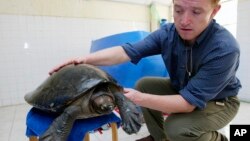The southern river terrapin is among the lesser-known of Cambodia’s many globally endangered species, which also include the Asiatic black bear, the Asian elephant and the Indochinese tiger.
The reptile, known locally as the royal turtle, was believed to be extinct in Cambodia until 2000, when a group of experts from the United States-based Wildlife Conservation Society (WCS) and the Cambodian Fisheries Administration rediscovered them in the Sre Ambel River, in the western province of Koh Kong.
In the same year, WCS initiated a project to protect this endangered species, which has seen startling success, restoring a population that it is believed had shrunk to a perilous 33 in Cambodia.
Heng Sovannara, project manager who works on royal turtle protection for WCS, said the breeding program had raised their number to 248 turtles.
“It is vitally important to protect these turtles as they are prone to extinction if there is no proper protection,” he said, adding that the royal turtle (Batagur affinis) can also be found in Indonesia, India and Bangladesh.
In the wild, the turtles mate in mangroves and hatch their eggs on sandy riverbanks, with hatchlings appearing about 100 days later.
“Every year there are approximately 10 female turtles that can produce hatchlings,” Mr. Sovannara said. The species is capable of mating until 25 years of age, and eventually weighs between 30 and 40 kilograms.
Since 2000, the WCS-run breeding program has successfully reared in captivity and released 146 of the rare creatures. That includes 24 that were released just last month.
The recently released reptiles have been fitted with radio transmitters to track their whereabouts and movements in order to help protect them. Protection is also provided by local people, who once collected the nests of royal turtles—a major cause of their endangered status—but are now paid to search for and watch over the nests.
WCS says that using this method, 39 nests, with a total of 564 eggs, have been protected since 2001, allowing 382 royal turtles safely to hatch.
But even once they have hatched, young terrapins are vulnerable to predators such as water birds and monitor lizards. And since they are also easily entangled by fishing gear, the WCS and the government’s Fisheries Administration in 2006 initiated a new program known as “head start” to protect new borns.
“After turtles hatched from protected enclosures on a sandbar, they were transferred to a facility and raised for several years in captivity,” a news release from WCS said of the 24 terrapins released in July. “This enabled them to reach a size where they would be less prone to predation upon release.”
WCS is also working with the government, and other environmental groups—Turtle Survival Alliance, Wildlife Reserves Singapore and Building Trust International—to develop a sustainable facility that will house a greater number of animals and encourage natural breeding of southern river terrapins and other endangered species.
The name royal turtle (andeuk luong or andeuk sarsai in Khmer) comes from the southern river terrapin’s history in Cambodia as a species protected by Royal Decree. In the past, their eggs were considered a delicacy and served only to Cambodian kings.
According to a more recent Royal Decree, the 2005 Designation of Animals and Plants as National Symbols of the Kingdom of Cambodia, royal turtles, are considered one of Cambodia’s seven national symbols and the country’s national reptile.
“They are different from other types of turtles as they can live both in fresh water and the sea,” Mr. Sovannara said.
Eang Sophalleth, spokesman for the Ministry of Agriculture and Forestry, encouraged Cambodian citizens to embrace the their national reptile and get involved in protecting the species.
“The participation of every Cambodian citizen, as well as the experts at protecting endangered species, is needed,” he said. “If we work together, we will get a good result.”







